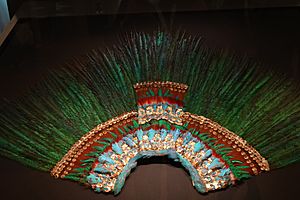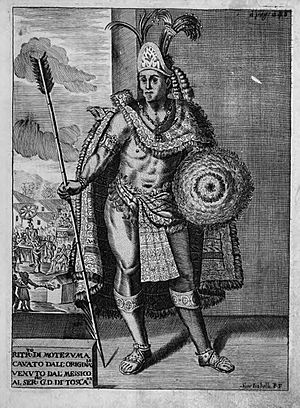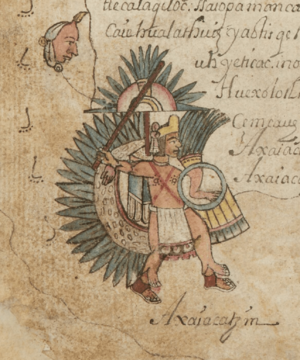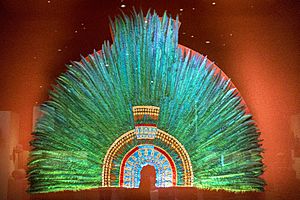Montezuma's headdress facts for kids
Quick facts for kids Moctezuma's headdress |
|
|---|---|
 |
|
| Material | Feathers of quetzal, Lovely cotinga, Roseate spoonbill, Piaya cayana, gold |
| Size | 116 cm (46 in) high, 175 cm (69 in) diameter |
| Present location | Museum of Ethnology, Vienna, Austria |
| Identification | 10402VO |

The Moctezuma's headdress is a beautiful piece made from feathers. Many people believe it belonged to Moctezuma II. He was the last tlatoani (emperor) of the Aztec Empire when the Spanish arrived.
This special feather item is also known as a quetzalāpanecayōtl. It is made from bright quetzal feathers and other bird feathers. It also has small pieces of gold sewn onto it.
Today, the headdress is kept in the Weltmuseum Wien in Austria. There is a disagreement between Austria and Mexico about who should own it. This is because no other similar feather artworks from that time remain in Mexico.
What Does the Headdress Look Like?
Over many centuries, the feathers of the headdress have become old and worn. It stands about 116 centimeters (45 inches) tall. It is also about 175 centimeters (69 inches) wide.
The headdress looks like several circles of different colored feathers. These circles are arranged in a half-moon shape.
- The smallest circle is made of blue feathers from the Lovely cotinga bird. It has small gold plates shaped like half-moons.
- Next, there is a layer of pink feathers from the Roseate spoonbill.
- After that, there are small quetzal feathers.
- Then comes a layer of red-brown feathers from the squirrel cuckoo. These feathers have white tips. This layer also has three bands of small gold plates.
- The largest part has 400 quetzal tail feathers placed very close together. Some of these feathers are 55 centimeters (21 inches) long.
The quetzal feathers in the middle of the headdress stand taller than the feathers on the sides. Leather straps are attached to the headdress. These straps would have held it onto the wearer's head.


While it is often called a headdress, some people think it might have been used in other ways. In old Aztec drawings called Aztec codices, similar items are shown. Priests wore them during a festival called Xocotlhuetzi.
However, similar items are also shown as other objects. For example, in the Codex Cozcatzin, Emperor Axayácatl is shown in a battle. He wears a feather battle standard and a large device on his back. Both look like the headdress.
In all these old drawings, the feather item seems connected to the god Quetzalcoatl. But there is no direct proof that this specific headdress belonged to Moctezuma.
History of the Headdress

Even though it is linked to Moctezuma, we don't have clear records of where the headdress came from. It also doesn't look exactly like the headdresses shown in Aztec drawings of their nobles.
European researchers became interested in the headdress in the late 1800s. People like Ferdinand von Hochstetter and Eduard Seler studied it. An American expert named Zelia Nuttall was the one who identified it as a quetzalapanecayotl.
In 1878, the headdress was repaired. At that time, people thought it was a mantle (a type of cloak) rather than a headdress. We know it has been in the collections of Archduke Ferdinand in Austria since 1575.
In the early 1800s, it was moved to the Museum of Ethnology in Vienna. It was placed there with other religious items linked to the gods Quetzalcoatl and Ehecatl.
The governments of Mexico and Austria have talked about returning the headdress to Mexico. However, a group of experts from both countries decided it was too delicate to move. They recommended that it stay in Vienna to protect it.
See also
- Xokonoschtletl Gómora — A Mexican activist who has worked to bring Moctezuma's headdress back to Mexico.
- In Spanish: Penacho de Moctezuma para niños

